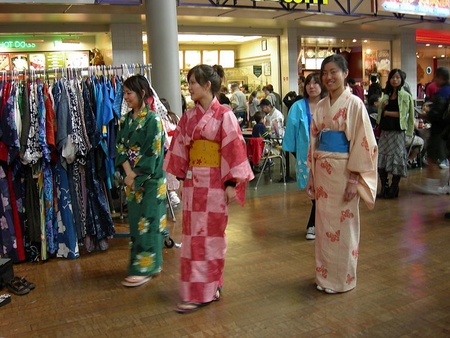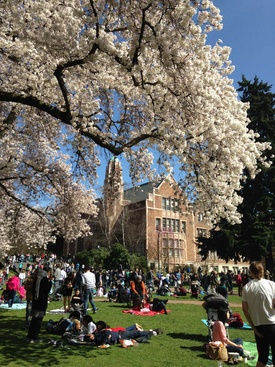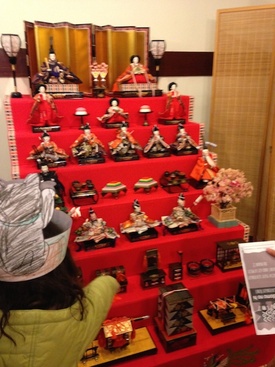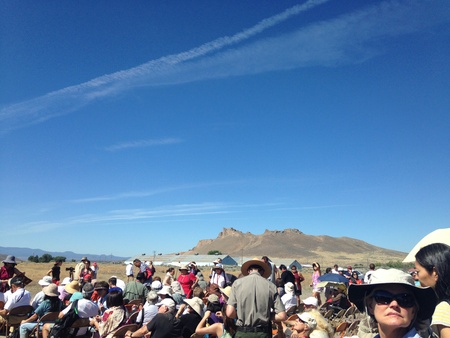Happy New Year, everyone! 2018 marked a significant milestone for me—it’s been 20 years since I moved to Washington State from my home state of California. I wasn’t sure where to look for communities or events when I moved up here, and I felt pretty lonely for a while. I have come to learn about the many festivals and events that happen each year in the Seattle/Tacoma area. So I have created this guide for anyone who is moving here from out of state, or is interested in visiting the area during special events. Please feel free to leave comments about any events that are missing from this list. I have provided links and details where I could find them for 2019 events.
* * * * *
January: Mochitsuki on Bainbridge
Mochitsuki festival. On Bainbridge Island, a short ferry ride from Seattle, many gather for the Island’s annual mochitsuki festival to enjoy hands-on traditional mochi making (and eating). Celebrating its 30th anniversary in 2019, it’s sponsored by the Bainbridge Island Japanese American Community (BIJAC). In addition to the community mochitsuki itself, taiko performances, community history talks, and film showings are part of the festivities. Tickets are free.
February: Days of Remembrance
Created by activists in the Seattle area in 1976, Days of Remembrance have now spread to other cities around the nation. They are meant to commemorate the signing of Executive Order 9066 by President Franklin D. Roosevelt, authorizing the mass incarceration of Japanese Americans during World War II.
Look for Densho’s annual Day of Remembrance in February, which now draws hundreds of attendees and noted speakers. Densho is a Seattle nonprofit devoted to preserving and digitizing the stories of Japanese American wartime incarceration. More about the very first Day of Remembrance in Seattle is postred at Densho’s blog, as remembered by journalist Frank Abe.
At Seattle University, the Minidoka Pilgrimage Planning Committee and the Friends of Minidoka also sponsor an annual Day of Remembrance taiko performance fundraiser which goes towards scholarships for Pilgrimage attendees who are youth as well as former incarcerates who are 80 years and older. This year’s concert is scheduled for February 19th.
March/April: Cherry Blossom Festival, Cherry Blossom Viewing
Cherry Blossom and Japanese Cultural Festival: Created in 1979, this festival now happens at Seattle Center (near downtown) as part of the year-round FESTAL program honoring different ethnic communities in the city. Visual arts, foods, games, and hands-on activities are offered. Climate changes have recently meant that the festival does not always coincide with cherry blossom time, but the festival itself is worth a trip nevertheless. This year the festival’s from April 26-28, 2019.
Cherry blossom viewing (ohanami): Also, though it’s not a formal event for any one Nikkei community, many visit the famous cherry blossom trees at the University of Washington quad in the spring. Viewing dates vary, but you can follow the UW News website or its Twitter account (@uwcherryblossom) for the latest updates about the times for peak bloom.
Other locations for viewing include the Japanese Garden at the Washington Park Arboretum, Seward Park, and the Kubota Garden.
May: Kodomo no hi (Children’s Day), Day of Remembrance (Tacoma)
Kodomo no hi (Children’s Day): Japanese Cultural and Community Center in Seattle hosts an annual Kodomo no hi festival for families each year, as a way of celebrating children. Attendees are treated to Japanese snacks, crafts, arts and culture demonstrations, and more. Admission is free.
Day of Remembrance: Tacoma has also hosted its own Day of Remembrance in May, commemorating the two days that the city’s Japanese Americans were forcibly evacuated from their homes.
June-August: Pilgrimages, Bon Odori, All Things Considered, From Hiroshima to Hope
As with other Japanese American communities that I knew in California, summer means two things: pilgrimage season and Bon Odori.
Pilgrimages: Nikkei communities and interested parties travel each year to the sites where Japanese Americans were incarcerated during World War II. Larger numbers from the area usually attend the pilgrimages to Heart Mountain, Minidoka, and Tule Lake, since these were the 3 sites where many Seattle-area Nikkei were incarcerated. The Tule Lake pilgrimage occurs every other year, while the others are annual.
Bon Odori: Bon Odori is a Japanese Buddhist tradition which celebrates the annual return of ancestral spirits. You can follow the “Bon Odori” circuit in the Seattle/Tacoma area which involves Seattle Betsuin Temple (the largest one), White River Buddhist Temple in Auburn, Tacoma Buddhist Temple, and the secular Bon Odori gathering in Olympia. The area organizers here tend to coordinate which dances are performed each year, so you can learn the dances at one location and perform them at most of the locations, if you’re so inclined. The events usually involve food, arts and crafts, folk dancing, and live taiko performances.
All Things Considered: In August I also look forward to the All Things Considered sale at the Hosekibako shop at Seattle’s Japanese Cultural and Community Center. Hosekibako is a resale shop offering gently used Japanese clothing, home goods, toys, and more, all for sale from community donations. The store is open year-round, but the sale usually offers some special items.
From Hiroshima to Hope: On August 6th each year, an all-volunteer committee in Seattle gathers the community to commemorate the bombing of Hiroshima and Nagasaki. A lantern floating ceremony occurs at Green Lake, Seattle, accompanied by taiko performances and speakers.
September-December: Japan Week, St. Peter’s Holiday Fair

Japan Week: Originally known as Aki Matsuri, this annual festival is now known as the Saturday of “Japan Week” and takes place at Bellevue College, a half-hour’s drive (give or take traffic) across Lake Washington from Seattle. Community organizations and vendors have booths, in addition to the games, workshops, music, and activities like the cosplay and karaoke contests.
St Peter’s Holiday Fair: In early December, look for the St. Peter’s Holiday Fair Episcopal Church Multicultural Arts and Crafts Fair. A Seattle church founded in 1908 by Japanese Anglican Christians, St. Peter’s holiday fair is multicultural, but with a strong Asian Pacific American emphasis on the arts and crafts and foods offered at its bake sale and plate lunch. Last year, my kids found handmade tote bags and stuffed animal “mochi” and “onigiri” ornaments and toys. More information about the church’s Japanese American history is available through videos at the church’s website.
Other places to look for events:
On Vashon Island, just another short ferry ride from Seattle, the Friends of Mukai holds regular open house events for the public to explore the Island’s Japanese American history and to share Japanese arts, crafts, and culture. On January 5, 2019, they are hosting an open house and mochi-making party.
In Seattle, the Nisei Veterans Committee hosts regular tours and a series of speakers each year.
A historically Nikkei church, Blaine Memorial United Methodist Church in Seattle holds regular events with many Japanese American attendees, including fall bazaars and spring fundraisers.
The region’s Japanese American Citizens League chapters including Seattle and the Puyallup Valley and Olympia are active, with events and banquets each year.
© 2018 Tamiko Nimura












